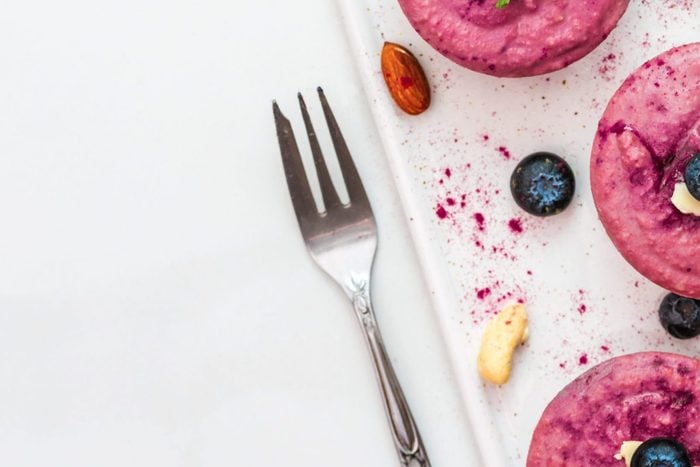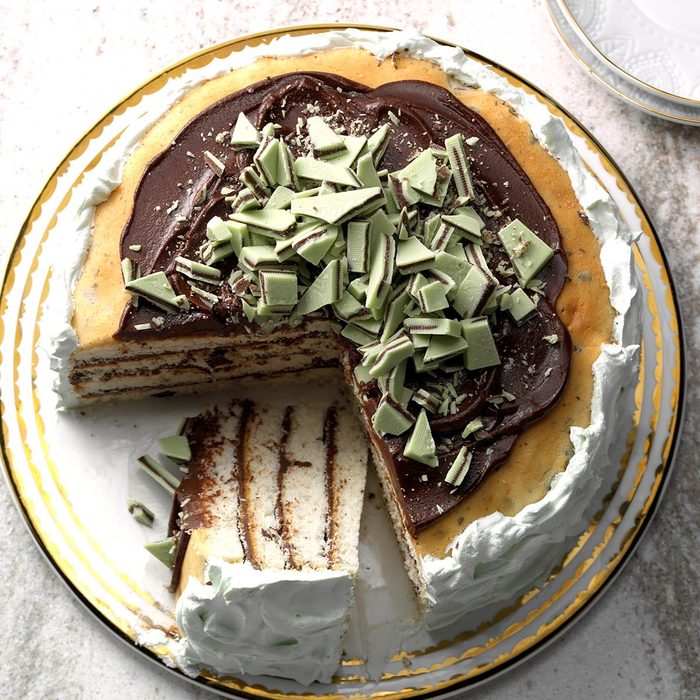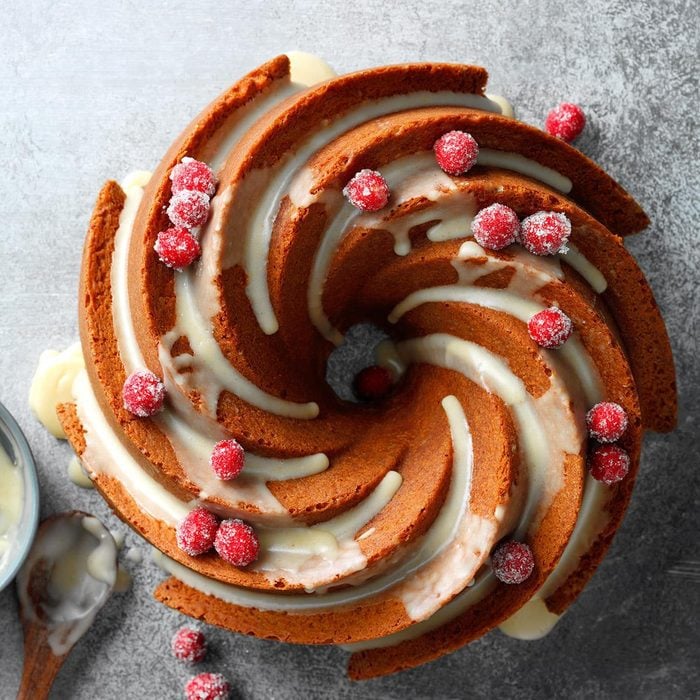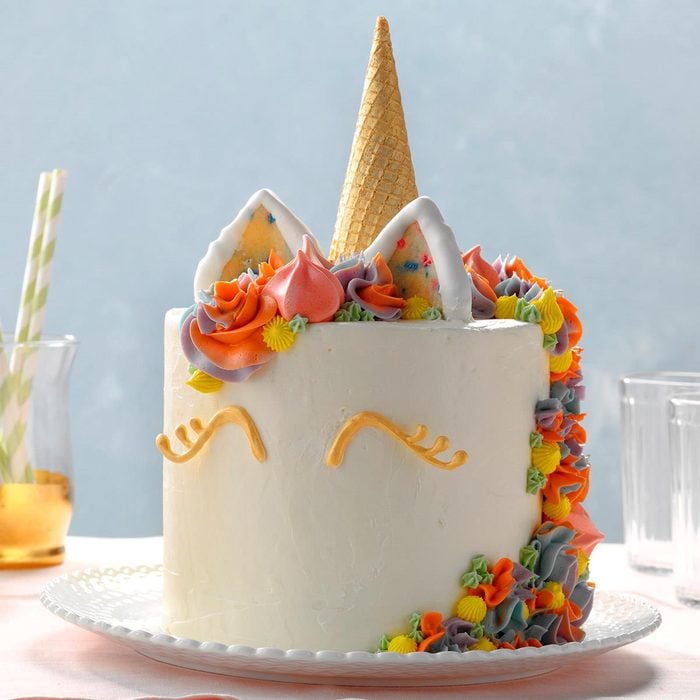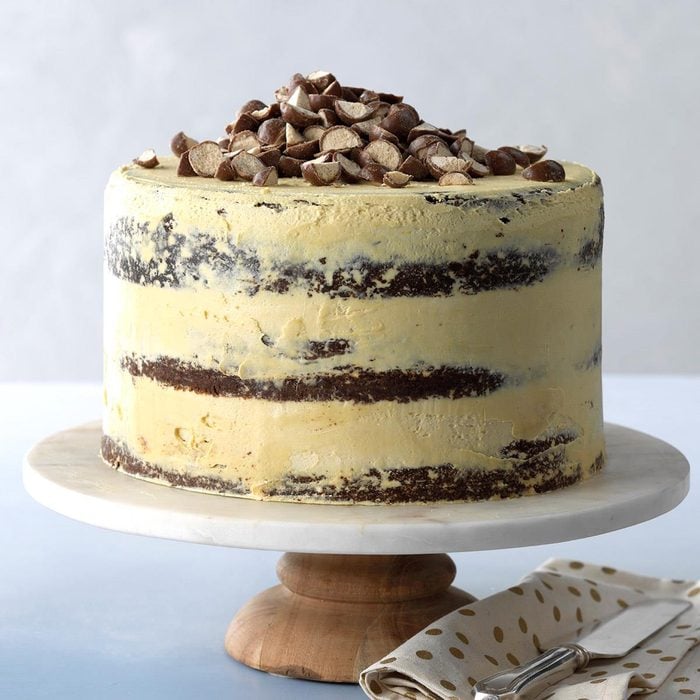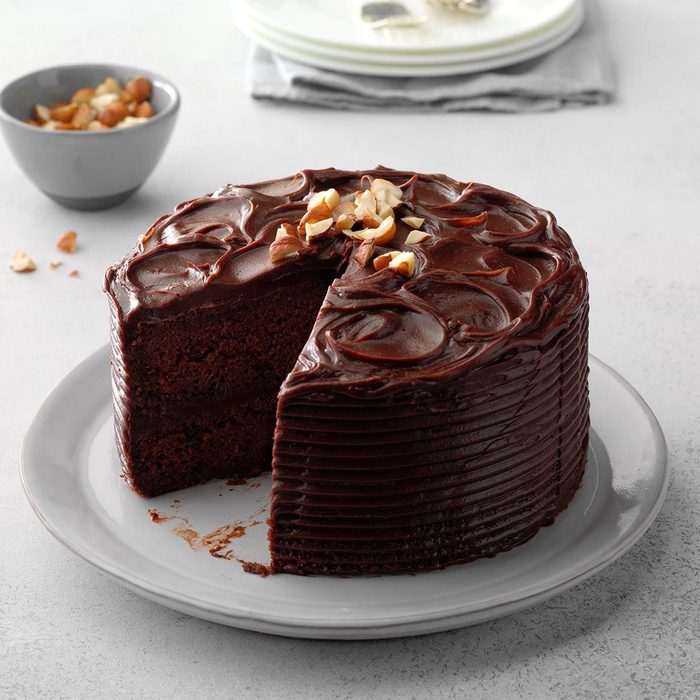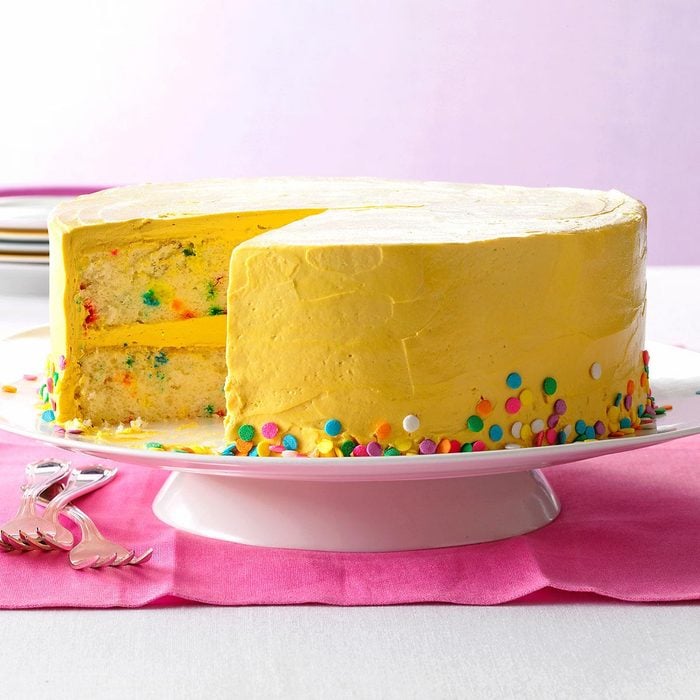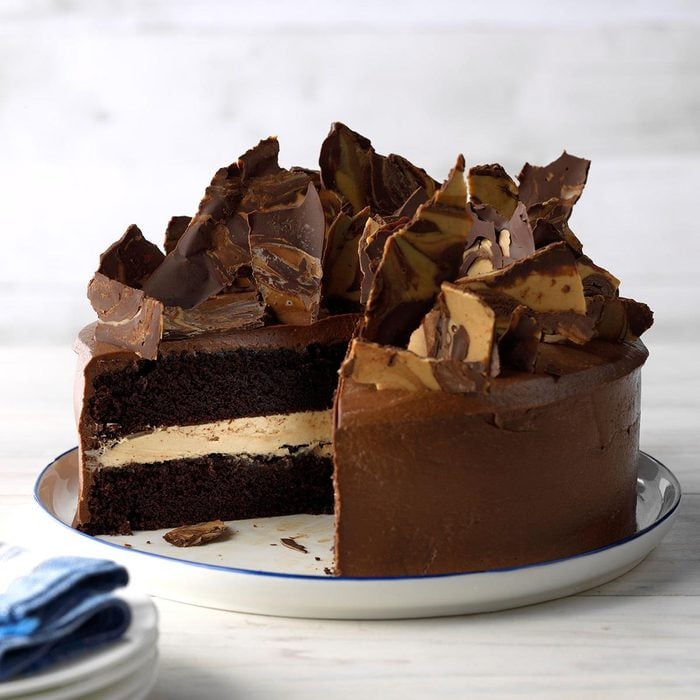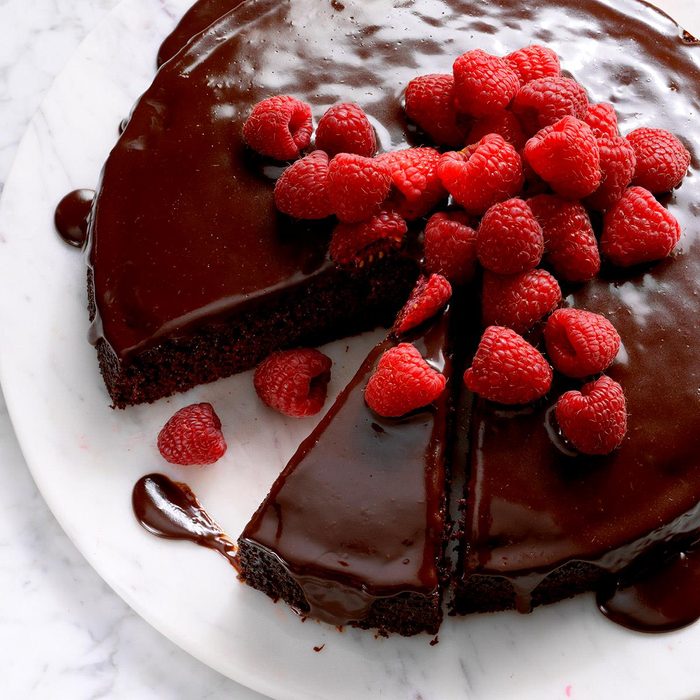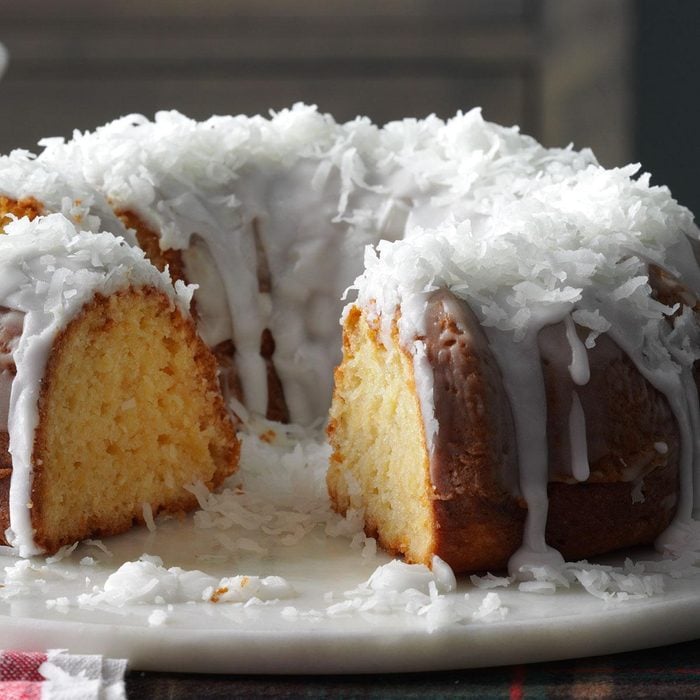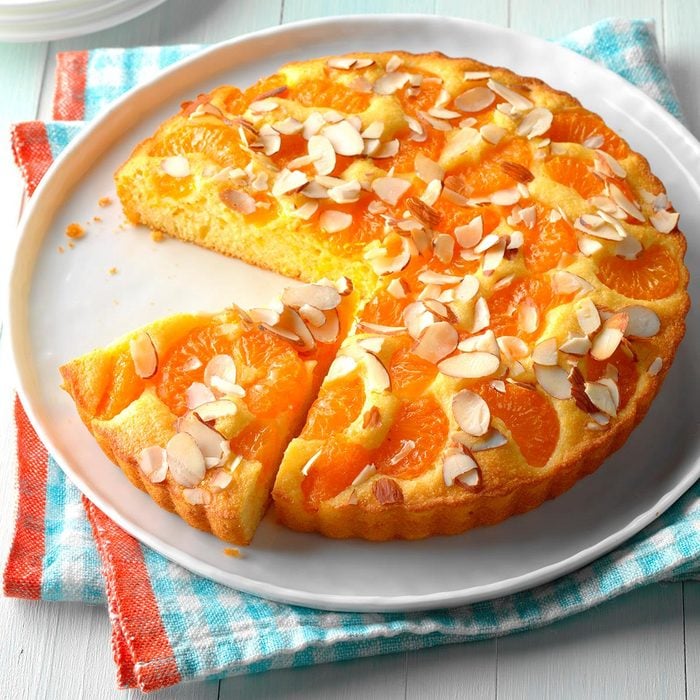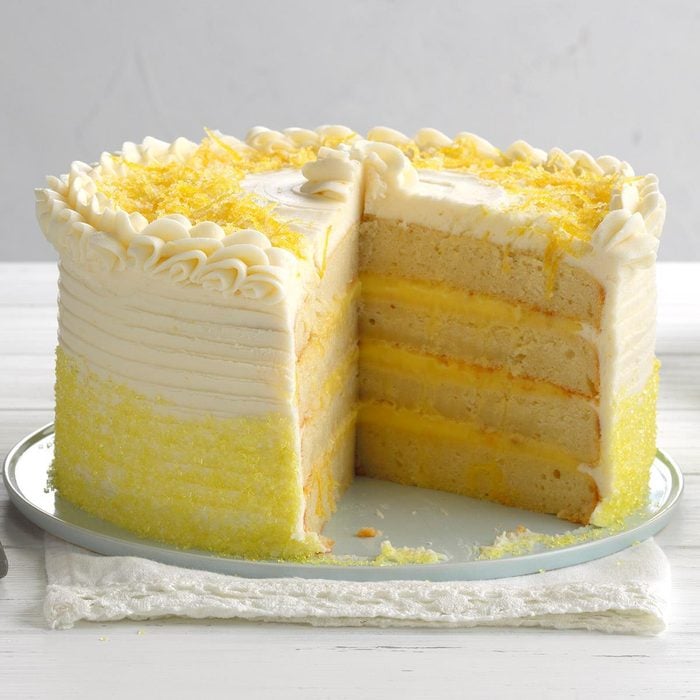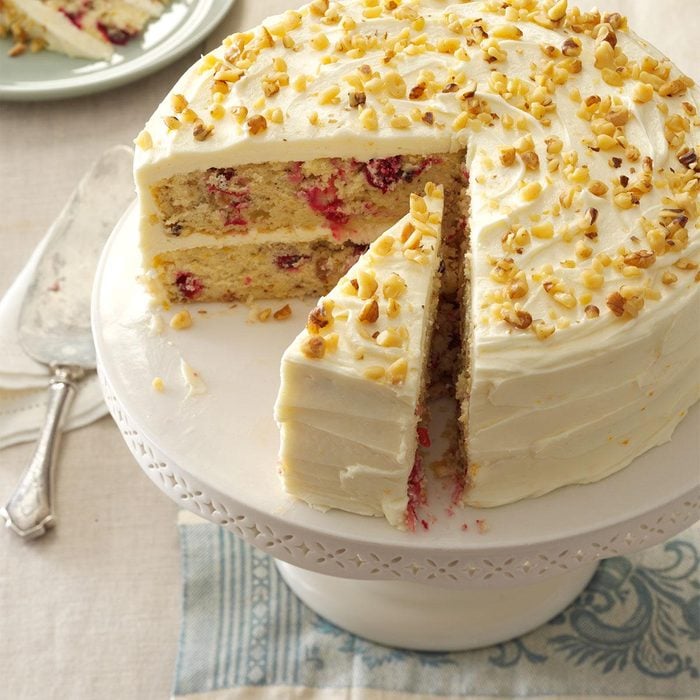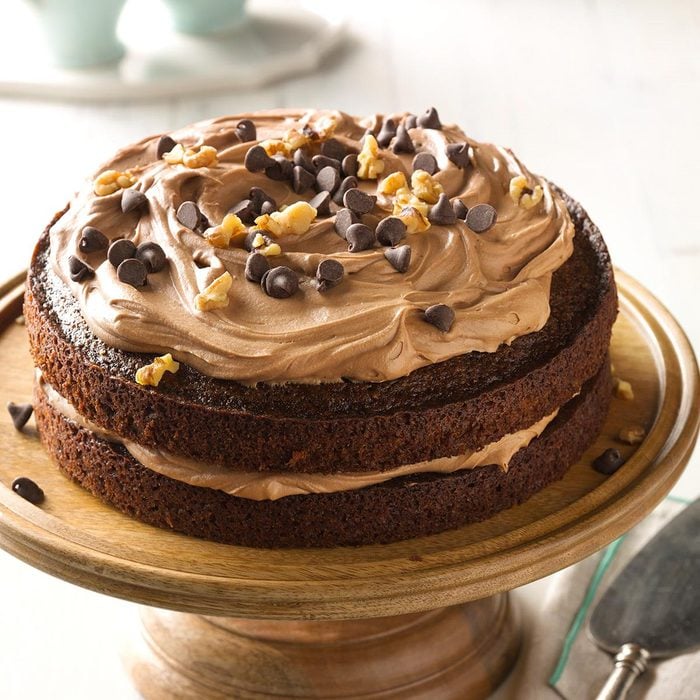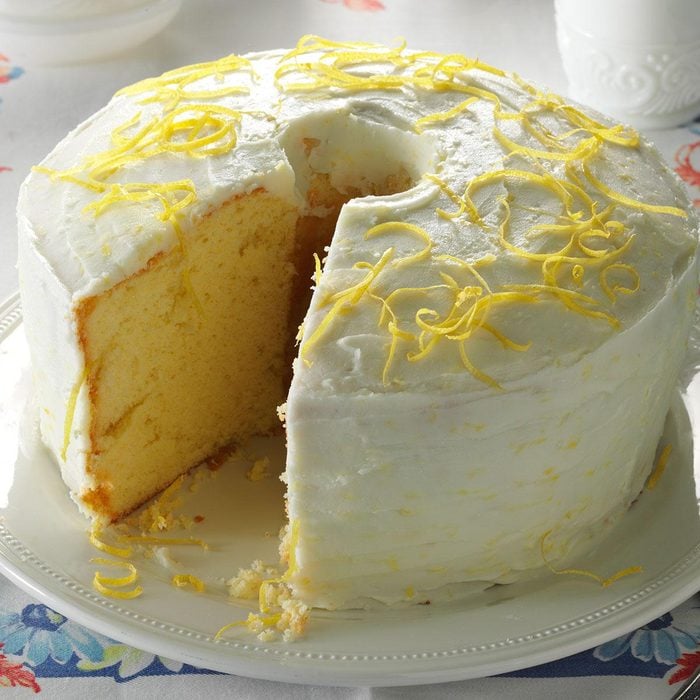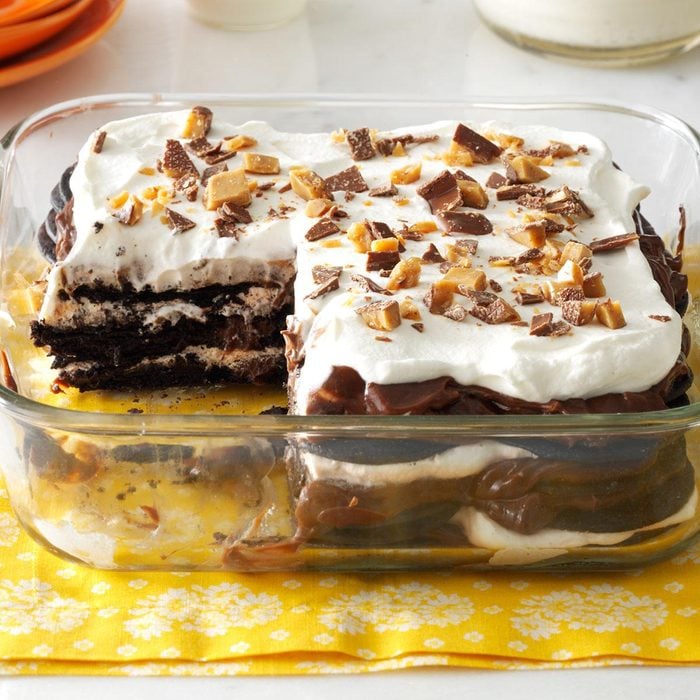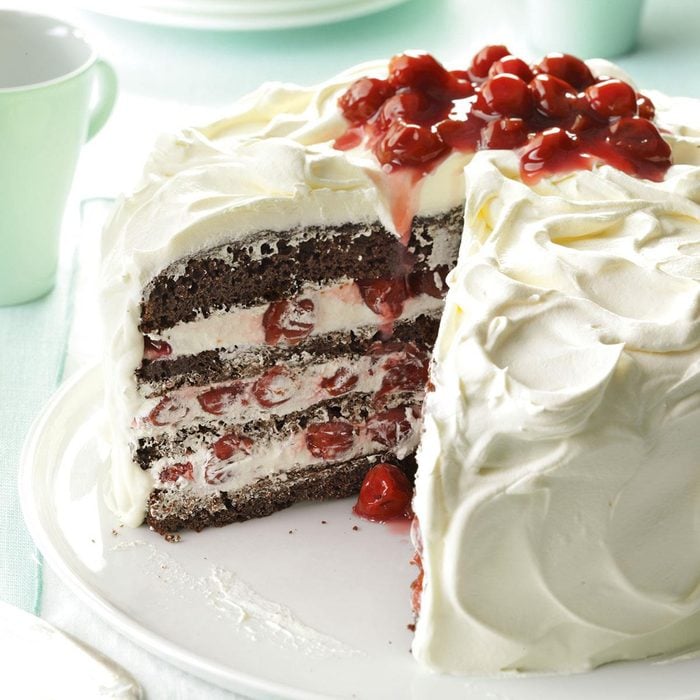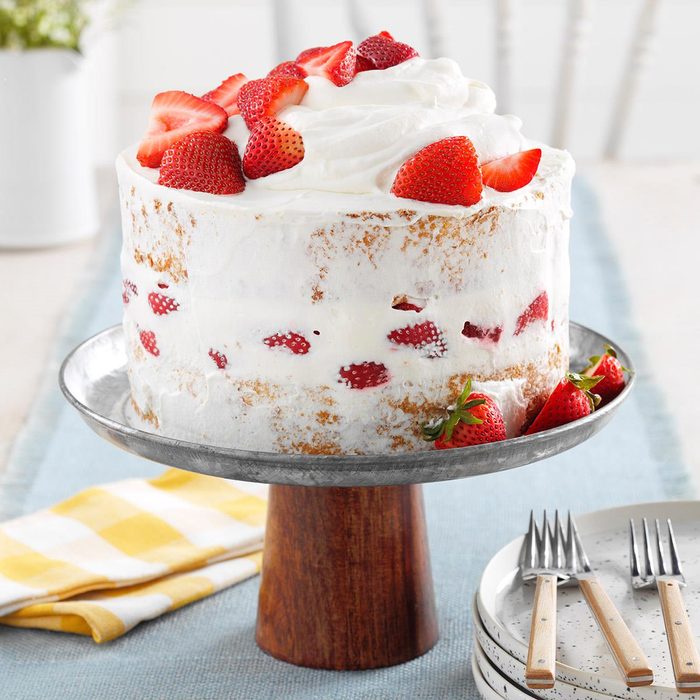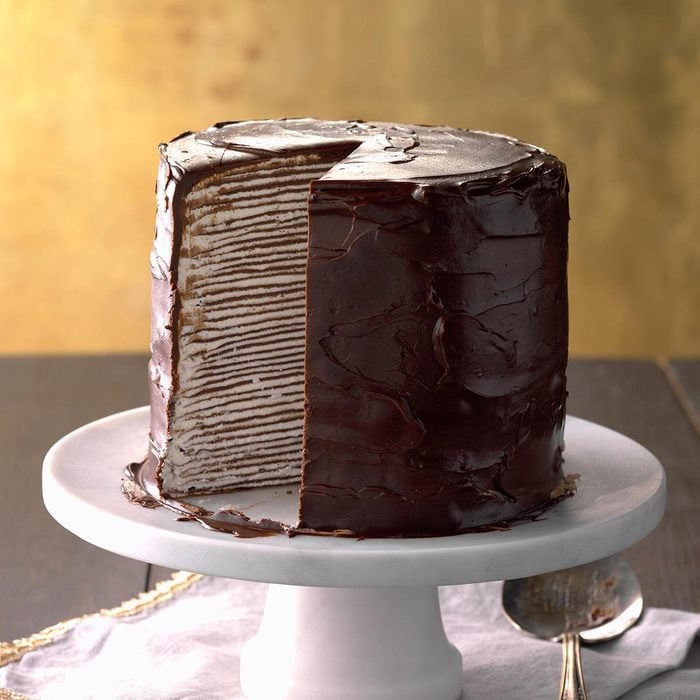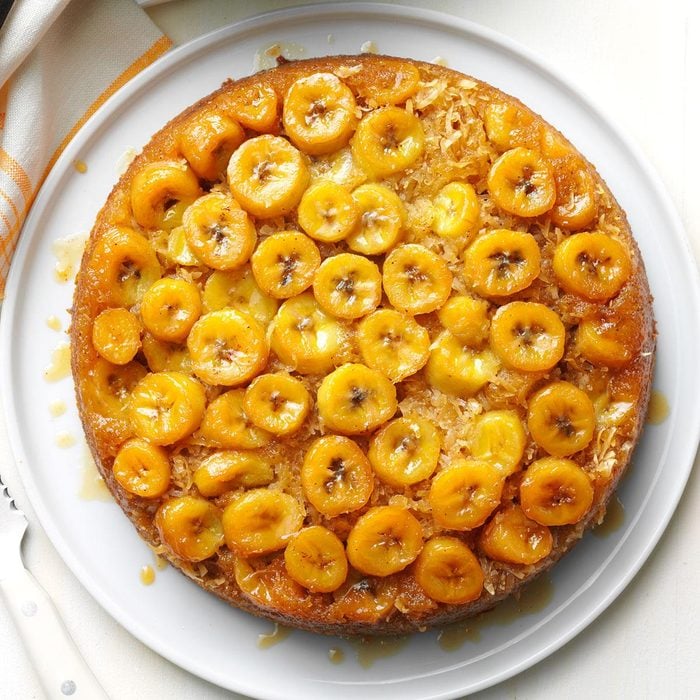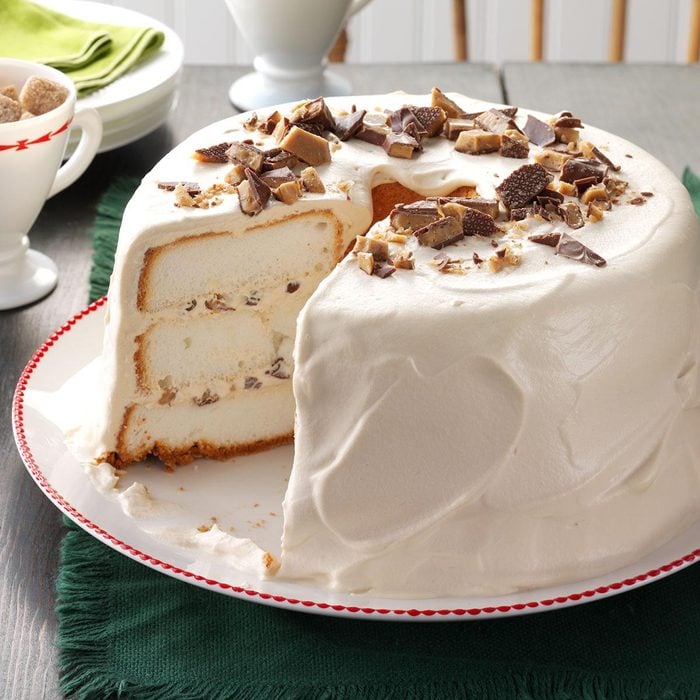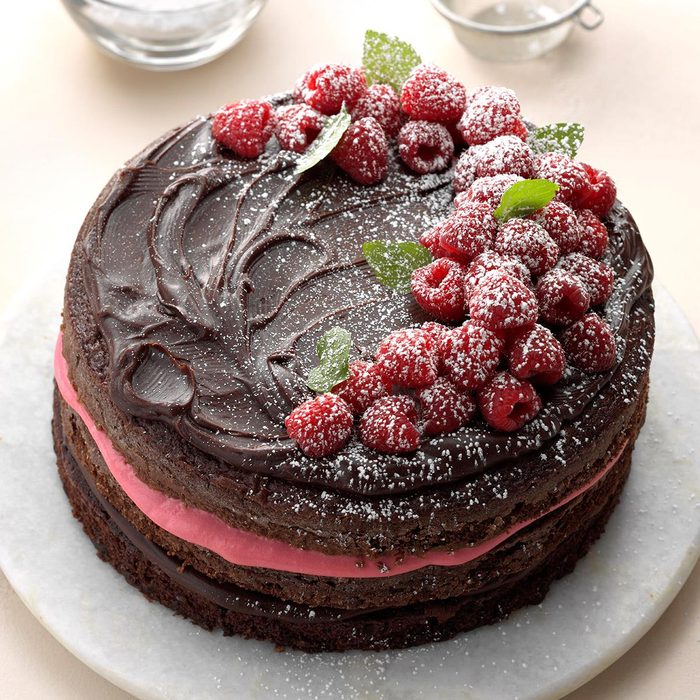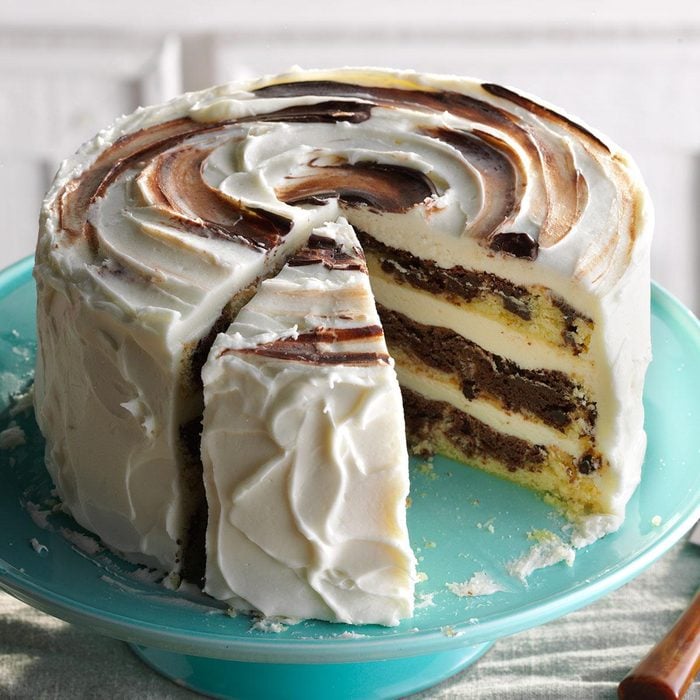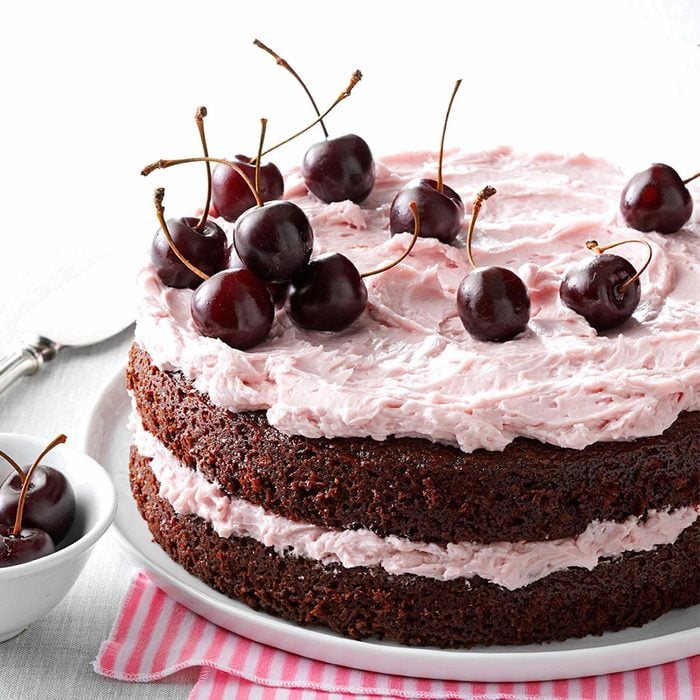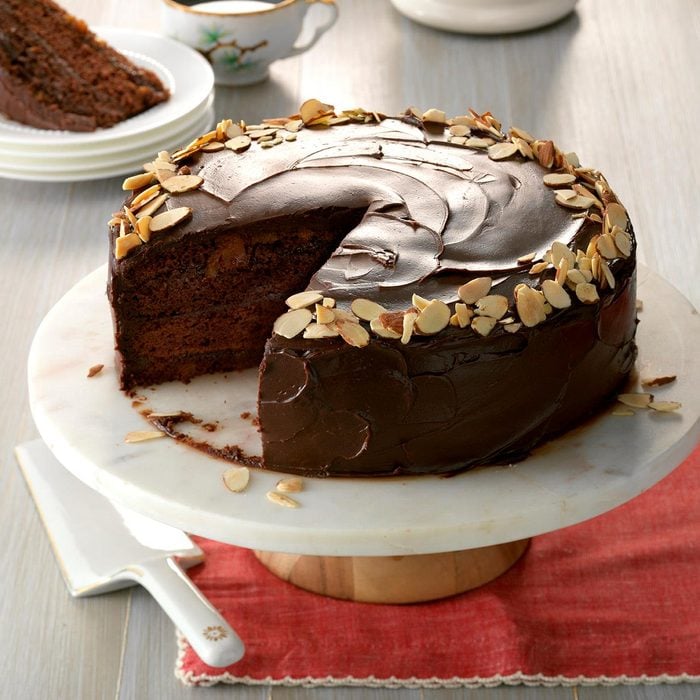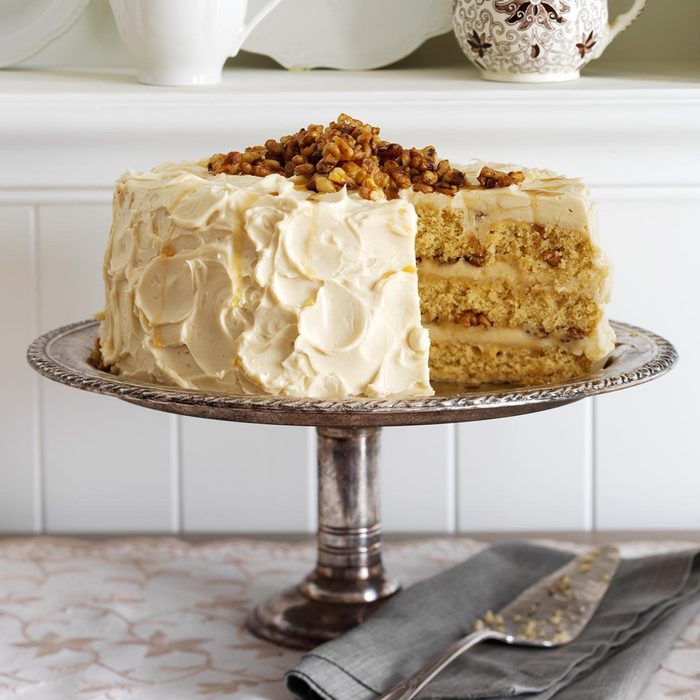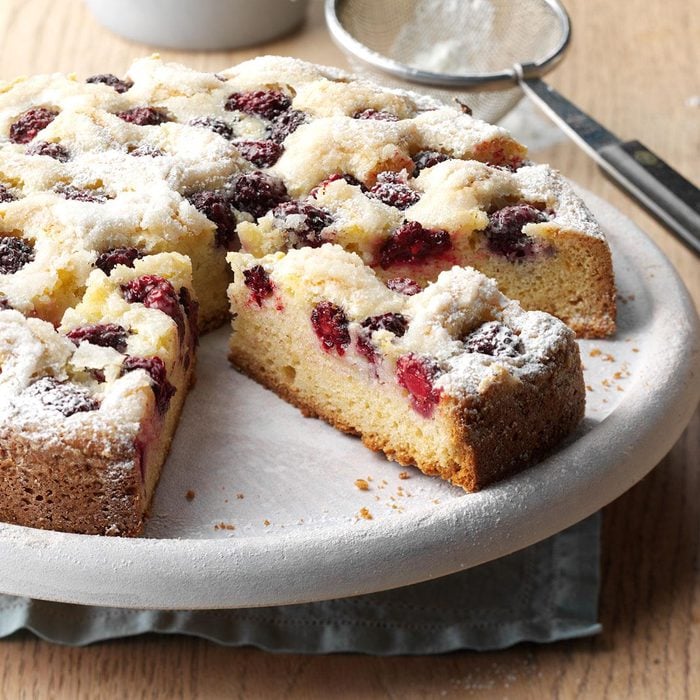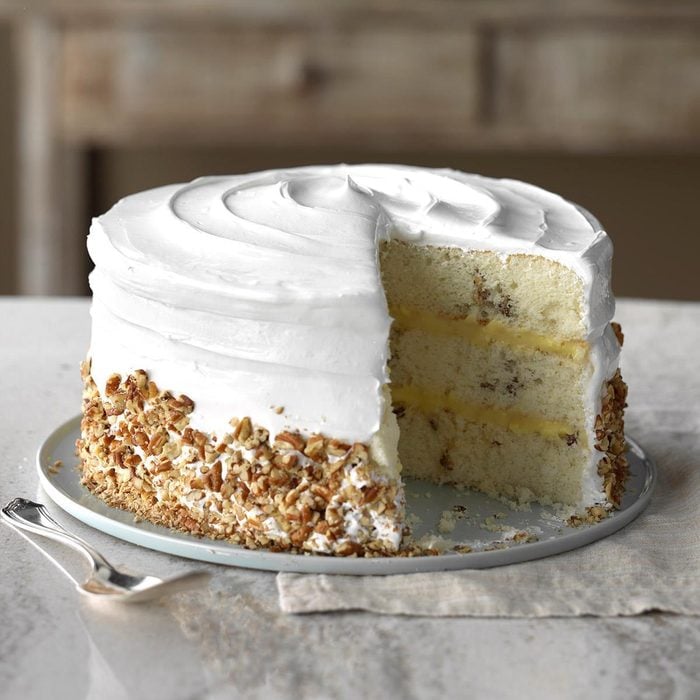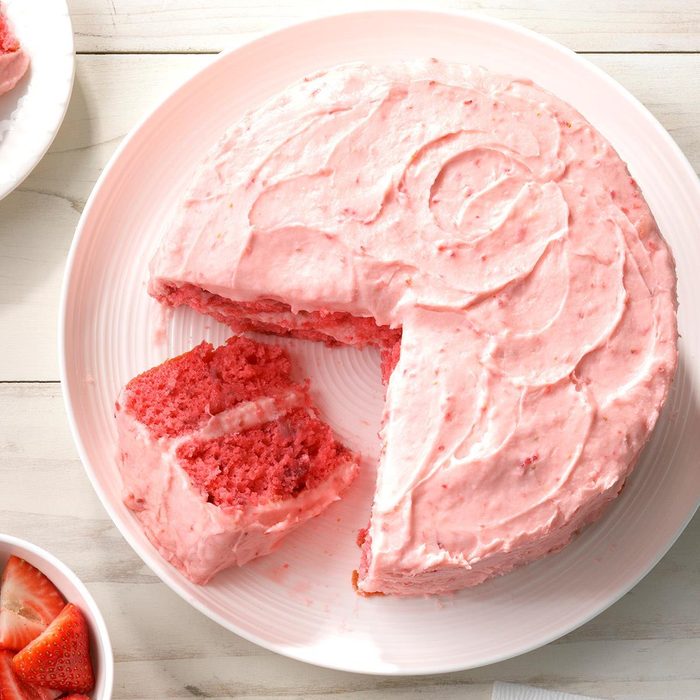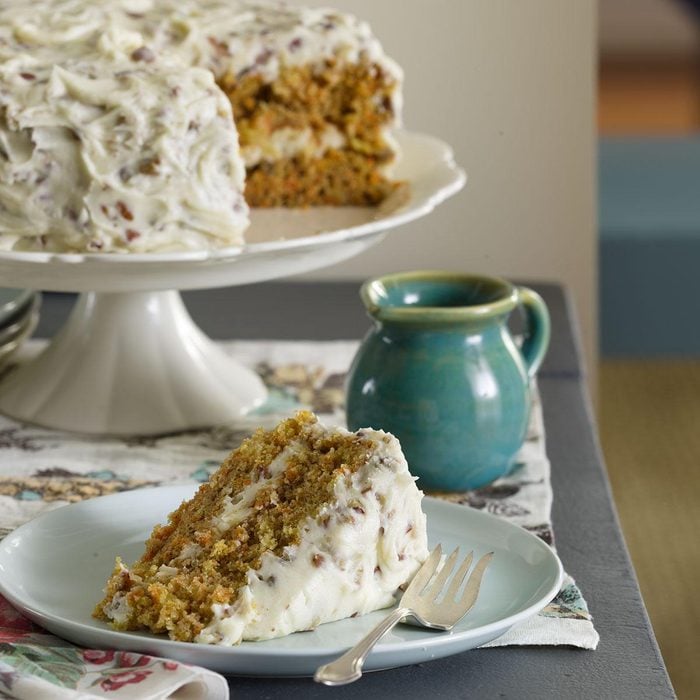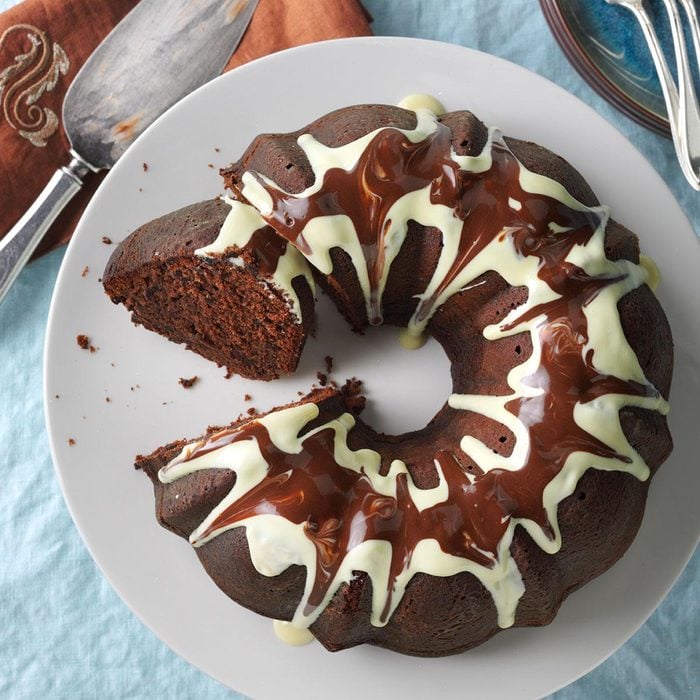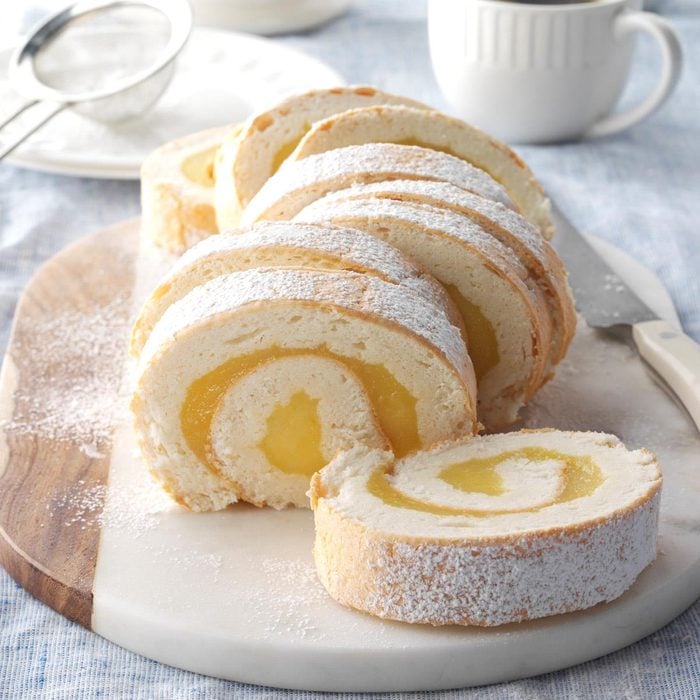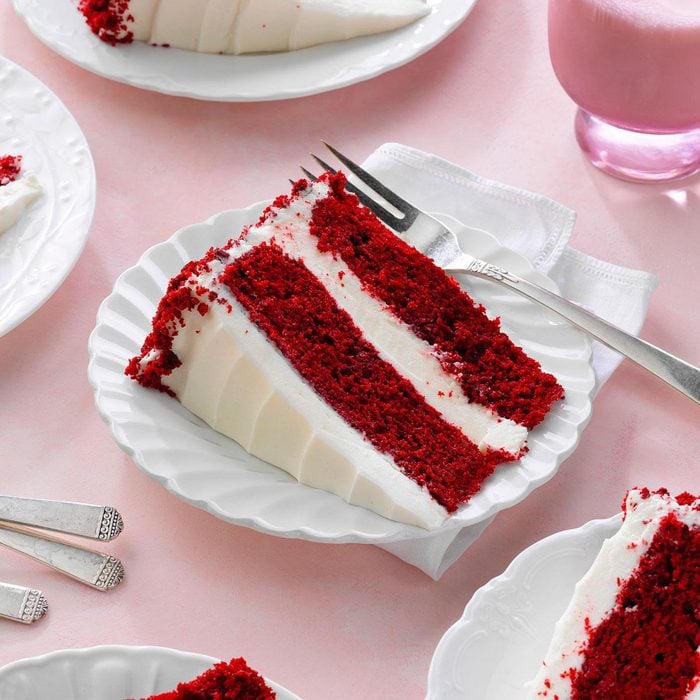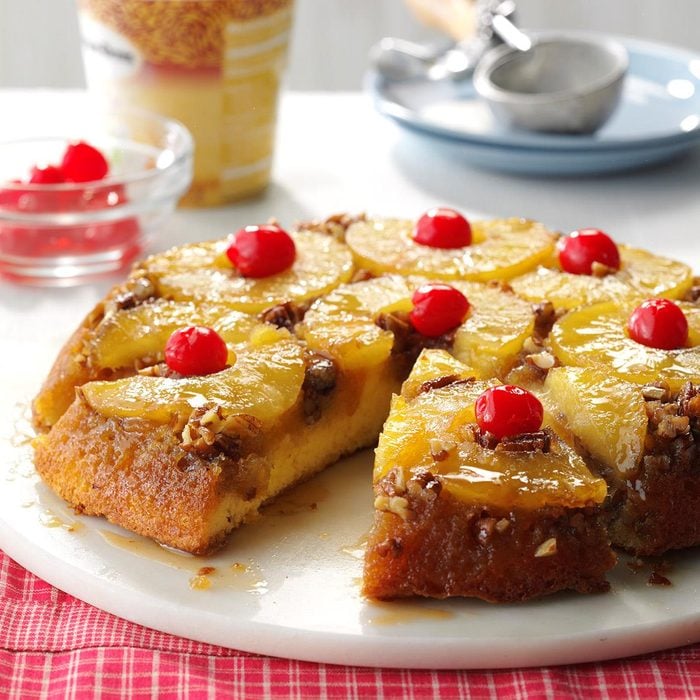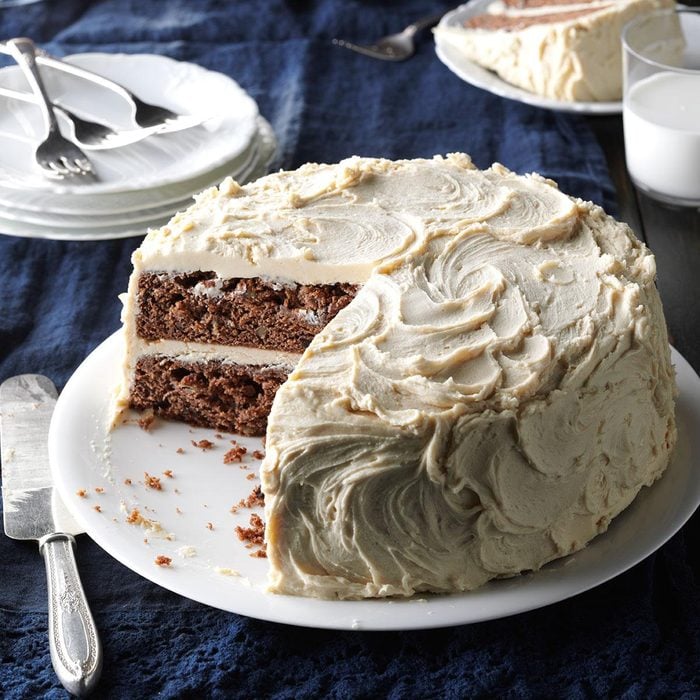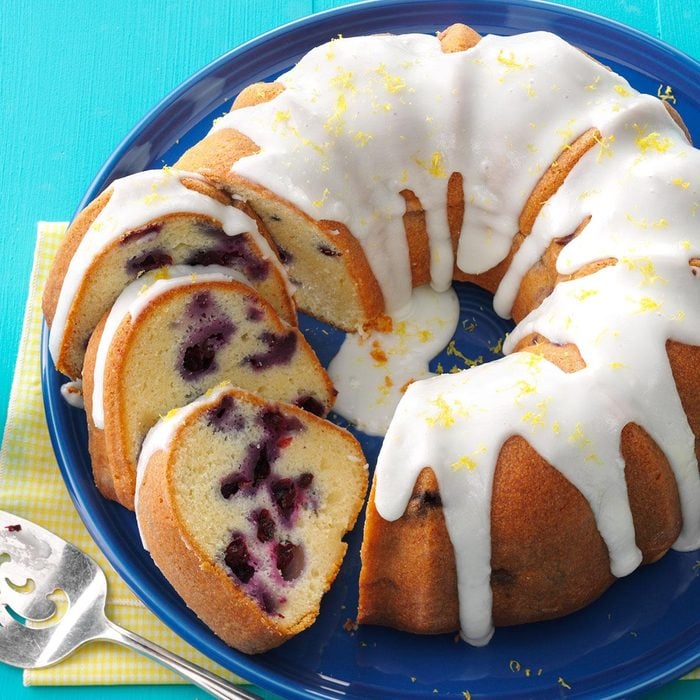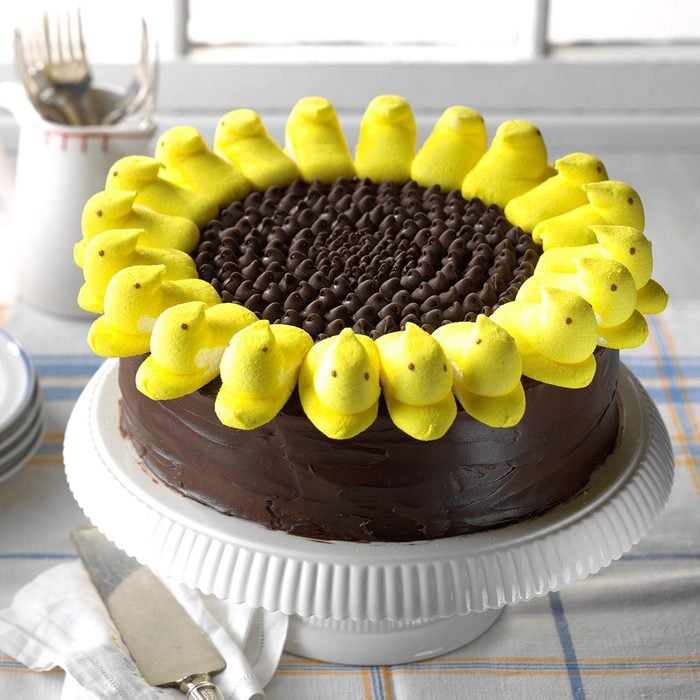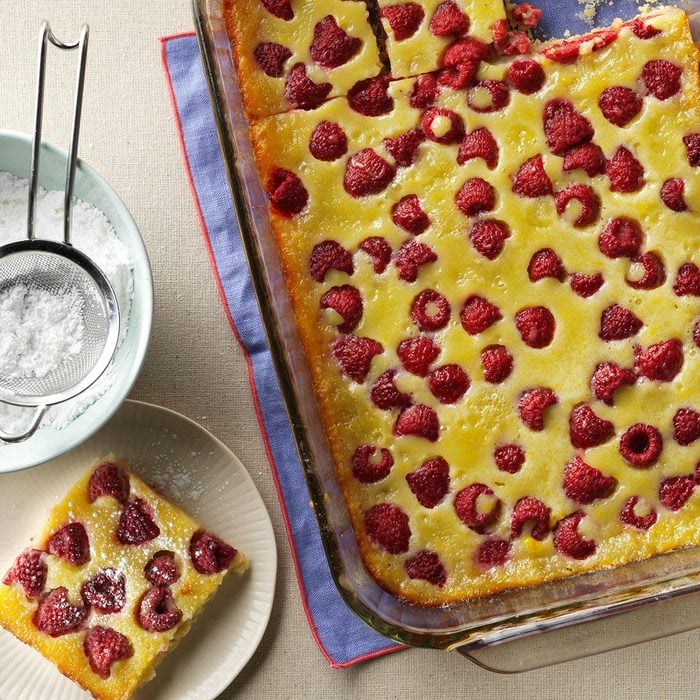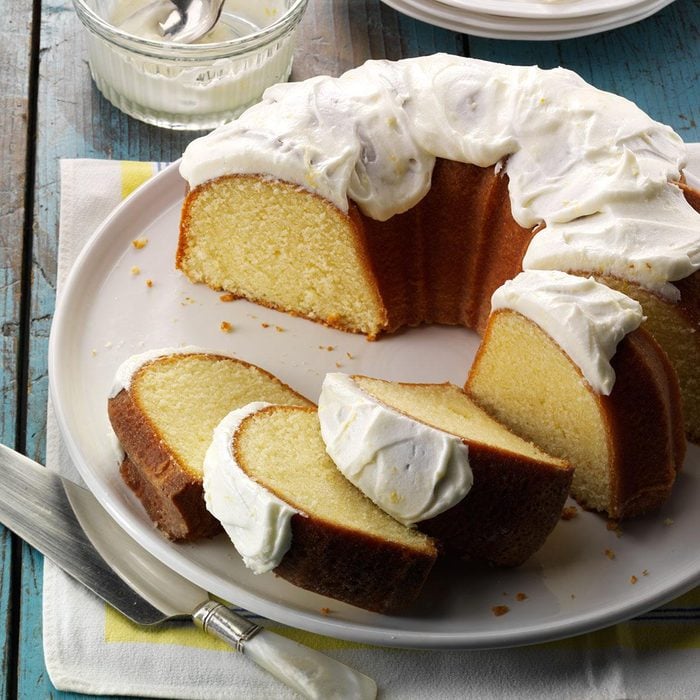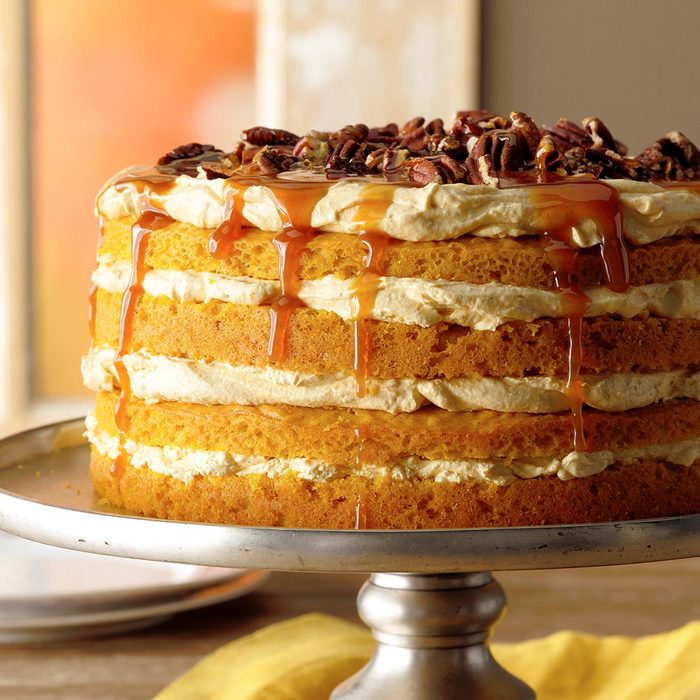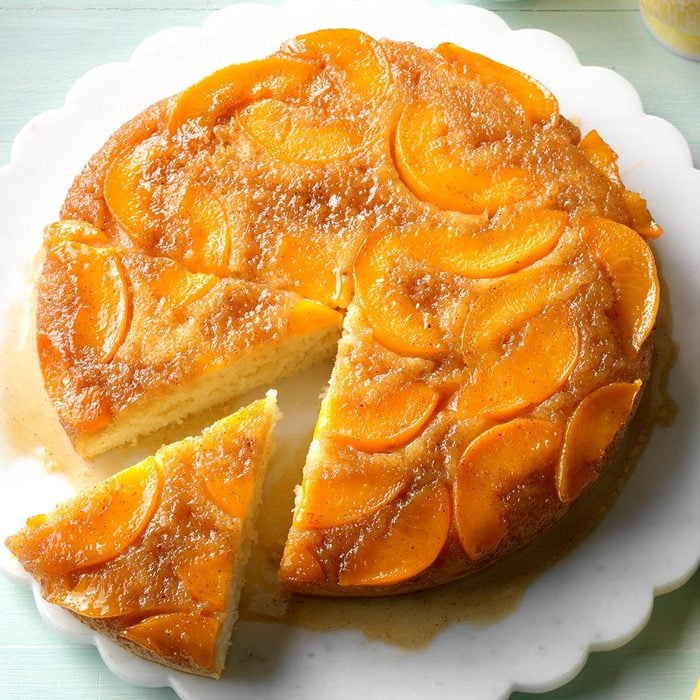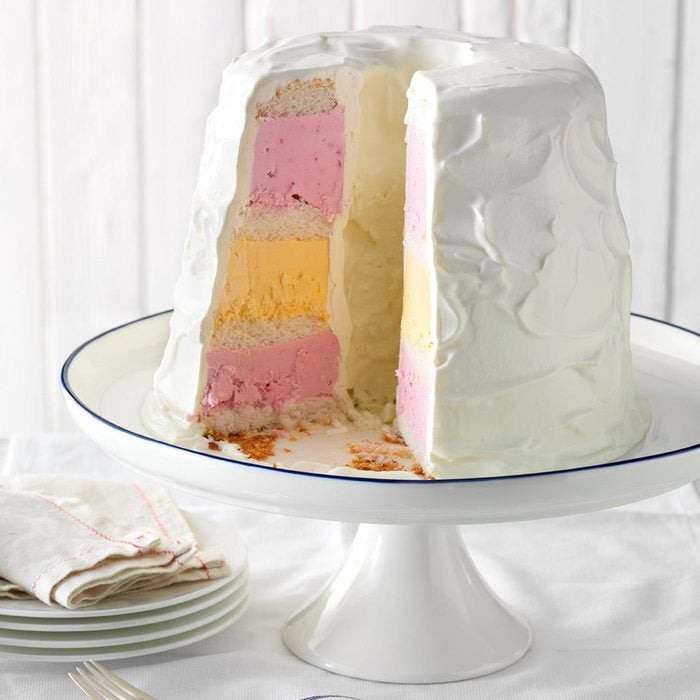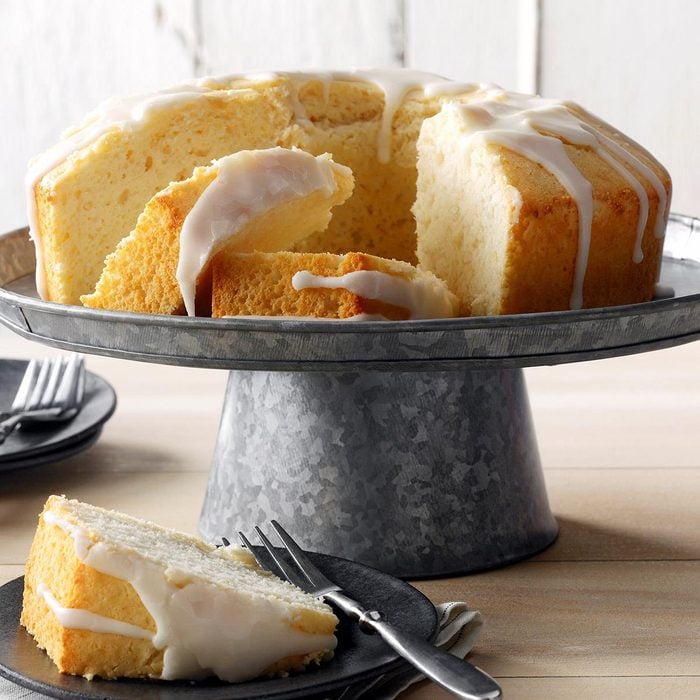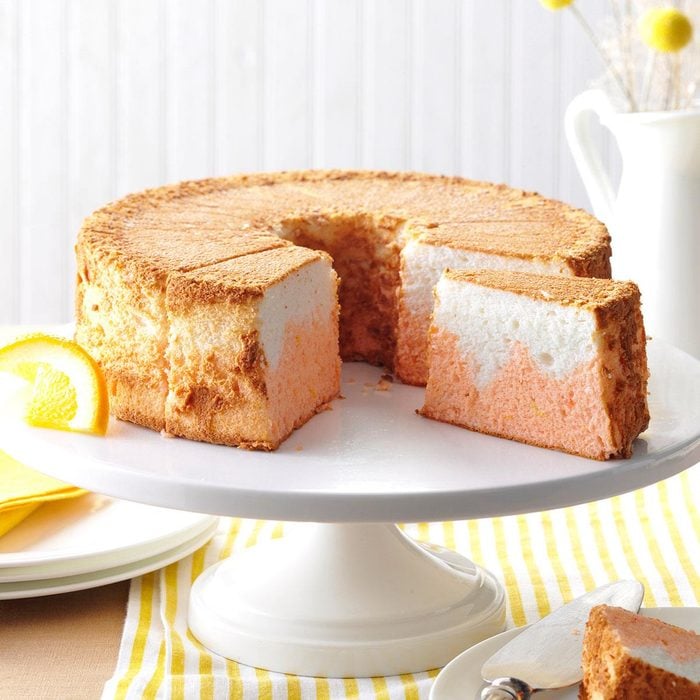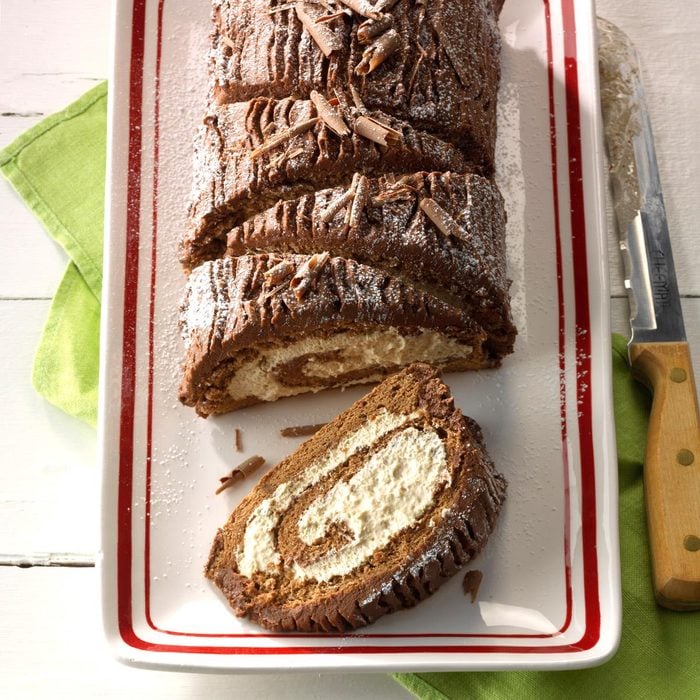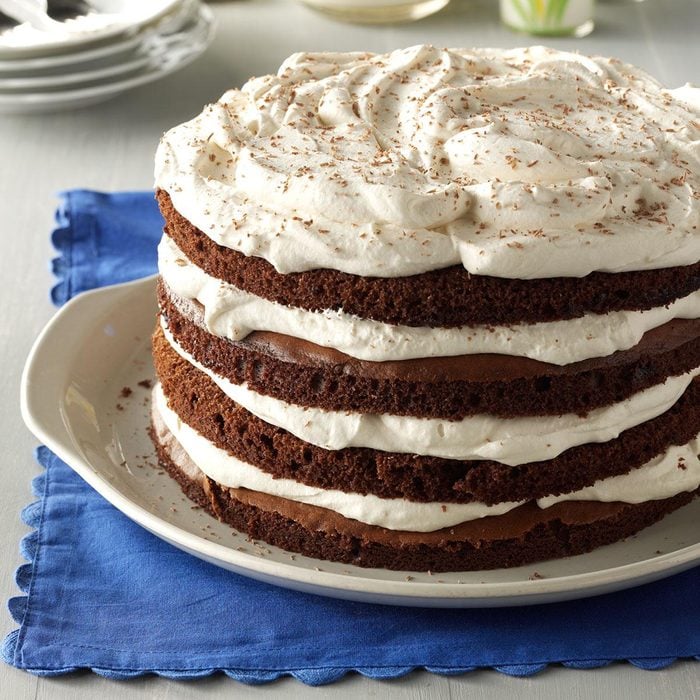Minted Chocolate TorteOur family has enjoyed this remarkable layered cake for years. It's a favorite for many occasions. —Barbara Humiston, Tampa, Florida
Ginger-Glazed Lemon BundtTangy ginger, tart lemon and puckery cranberries make this melt-in-your-mouth cake as crisp—and gorgeous—as autumn. —Taste of Home Test Kitchen
Unicorn CakeThis magical unicorn cake tastes as good as it looks. Baking in smaller pans creates impressive height, and a few simple decorating tricks turn it into a showstopping dessert. —Lauren Knoelke, Des Moines, Iowa
Malted Chocolate & Stout Layer CakeIf you want a dessert that will take the cake at a St. Patrick's Day celebration, look no further! The rich chocolate cake is incredibly moist and has a nice malt flavor that's perfectly complemented by the Irish cream frosting. —Jennifer Wayland, Morris Plains, New Jersey
Chocolate Hazelnut TorteMost cake recipes feed a crowd. So we came up with this elegant little cake that serves six. That's enough for two…with just the right amount of leftovers! —Taste of Home Test Kitchen
Mama's Spice CakeThis spice cake recipe has stood the test of time and it's one you'll probably hand down yourself.
Funfetti CakeWant to know how to make a Funfetti cake recipe from scratch? Our Test Kitchen provides you with a helpful guide sprinkled with tips for making this colorful cake.
Rich Chocolate Peanut Butter CakeThe combination of mocha and peanut butter will satisfy every sweet tooth at your table. The garnish is a little extra work, but what are special occasions for? —Tammy Bollman, Minatare, Nebraska
Ganache-Topped Chocolate CakeTo say this cake is elegant would be an understatement. It’s worthy of special occasions, but once you learn
how to make chocolate ganache, it's so easy to whip together that you can enjoy it any day of the week. —Taste of Home Test Kitchen
Pina Colada Tube CakeWe named this a “pina colada” cake because it has coconut, pineapple and rum. It’s a soothing finish at the end of a big spread. —Debra Keil, Owasso, Oklahoma
Citrus Cornmeal CakeCornmeal adds a rustic quality to this delicate dessert flavored with citrus and almond. It makes a great holiday party hostess gift and is sure to be a staple in your recipe collection. —Roxanne Chan, Albany, California
Lemon Ricotta CakeThis lemon ricotta cake recipe is a family gem that was passed down from my grandmother and mother. Garnished with shaved lemon zest, the moist four-layer cake is the perfect dessert when you want to impress. —Nanette Slaughter, Sammamish, Washington
Rainbow Cake with CloudsSome cakes stand on their own without icing. For this bright Rainbow Cake, use a little whipped cream to make fluffy clouds. —Janet Tigchelaar, Jerseyville, Ontario
Chocolate Swirl DelightI made a few updates to a great recipe and ended up with an impressive dessert. Everyone loves its light texture and chocolaty flavor. —Lynne Bargar, Saegertown, Pennyslvania
Brown Sugar Pound CakeThis tender pound cake is the first one I mastered. You'll want to eat the browned butter icing by the spoonful. It tastes like pralines. —Shawn Barto, Winter Garden, Florida
Cranberry Layer CakeI adapted a Bundt cake recipe to create this layer cake. Cranberries, walnuts and homemade frosting make it taste so delicious that you'd never guess it starts with a convenient cake mix. —Sandy Burkett, Galena, Ohio
Chocolate Carrot CakeFinely shredding the carrots gives this cake an extra-nice texture. The walnuts sprinkled on top add crunch, but you can leave them off if you prefer. —Pamela Brown, Williamsburg, Michigan
Lemon Chiffon CakeLemon chiffon cake is soft and spongy, with a fresh lemon flavor in the cake and the luscious buttercream frosting. Plan to eat this cake quickly, as chiffon cakes don't last very long. But that shouldn't be a problem, given how delicious this cake is.
Double-Chocolate Toffee Icebox CakeMy mother-in-law taught me that anything tastes good if you use enough chocolate or cream. This no-bake dessert proves she was right. Sometimes I use chocolate graham crackers and stack up the layers in a 9-inch square pan. —Bee Engelhart, Bloomfield Township, Michigan
German Black Forest CakeAs far as I know, this cake recipe can be traced back to my German great-grandma. When I got married, my mother gave me a copy and I hope to someday pass it down to my children. —Stephanie Travis, Fallon, Nevada
Banana Split CakeThis banana split cake takes a twist on the beloved ice cream dessert with a timeless no-bake recipe. It’s so celebratory and eye-catching, no one will guess how easy it was to make.
Strawberry Mascarpone CakeDon't let the number of steps in this recipe fool you —it's easy to assemble. The cake bakes up high and fluffy, and the berries add a fresh fruity flavor. Cream cheese is a good substitute if you don't have mascarpone cheese handy. —Carol Witczak, Tinley Park, Illinois
Mille Crepe CakeNo other dessert has wowed family and friends the way this stunning crepe cake did the first time I made it. A showstopper in every sense of the word, it features layers of tender chocolate crepes and rich white chocolate buttercream frosting draped in a semisweet chocolate ganache. —Tina Sawchuk, Ardmore, Alberta
Banana Skillet Upside-Down CakeMy grandmother gave me my first cast iron skillet, and I've been cooking and baking with it ever since. Sometimes I add drained maraschino cherries to this banana skillet dessert and serve it with a ice cream. —Terri Merritts, Nashville, Tennessee
Toffee Angel Food CakeChopped toffee bits and whipped cream make the sweet flavor and light, moist texture of angel food even more indulgent. For best results, refrigerate the cake for at least an hour before serving. —Collette Gaugler, Fogelsville, Pennsylvania
Raspberry Fudge TorteThis special-occasion cake impresses all who see and taste it. People are surprised to hear that this torte starts with a simple cake mix—they're sure I bought it at a bakery. —Julie Hein, York, Pennsylvania
Marble CakeIn this striking marble cake, each layer is a swirl of chocolate and sour cream pound cake. The key is mixing one batter, adding melted chocolate to part of it, then "marbling" the two together to create the stunning effect.
Cherry Cola CakeCherry cola and marshmallows make a zippy chocolate dessert that is scrumptious topped with vanilla ice cream. — Cheri Mason, Harmony, North Carolina
Cinnamon Twirl Roly-PolyMy whole house smells incredible when this cake is in the oven. Change it up with other extracts—maple is heavenly. —Holly Balzer-Harz, Malone, New York
Red Velvet Marble CakeI watched my grandma prepare her red velvet showstopper many times for family get-togethers. The fluffy butter frosting perfectly complements the flavor of this gorgeous cake.—Jodi Anderson, Overbrook, Kansas
Sacher TorteGuests will be surprised to hear that this Sacher torte recipe starts with a convenient cake mix. Each bite features chocolate, almonds and apricots. —Taste of Home Test Kitchen
Maple Walnut CakeThis maple-flavored cake with candied walnuts honors beloved my grandpa, who made maple syrup when I was a child. It honors his memory and has proven to be a favorite with family and friends throughout the years. —Lori Fee, Middlesex, New York
Blackberry-Orange CakeMy grandmother made luscious fruit pies and cobblers using blackberries from her garden. I decided to follow her lead and create a blackberry cake that's always lovely with a summer meal. —Lisa M. Varner, El Paso, Texas
Coconut-Layered Pound CakeIf you love chocolate, almonds and coconut, this cake is for you. It comes together in a flash and tastes just like an Almond Joy candy bar! —Linda L. Nichols, Steubenville, Ohio
Majestic Pecan CakeThis recipe truly lives up to its name. The pecan-dotted cake is stacked in three layers, and made-from-scratch frosting is the crowning touch.—Karen R. Jones, Claypool, Indiana
Mamaw Emily's Strawberry CakeMy husband loved his mamaw's strawberry cake recipe. He thought no one could duplicate it. I made it, and it’s just as scrumptious as he remembers. —Jennifer Bruce, Manitou, Kentucky
Carrot Cake with Pecan FrostingMy husband constantly requests this homey, old-fashioned version of carrot cake. The frosting is still tasty even without the pecans. —Adrian Badon, Denham Springs, Louisiana
Decadent Fudge CakeEveryone loves the rich flavor in this decadent cake made with four types of chocolate. —Anna Hogge, Yorktown, Virginia
Moist Lemon Angel Cake RollTart and delicious, this pretty cake roll will tickle any lemon lover's fancy. Its feathery, angel food texture enhances its guilt-free goodness. —Taste of Home Test Kitchen
Red Velvet CakeOur red velvet cake recipe is traditionally southern with light, tender, ruby-red cakes held together with a rich vanilla frosting.
Skillet Pineapple Upside-Down CakeFor a change of pace, you can substitute fresh or frozen peach slices for the pineapple in this old-fashioned recipe. —Bernardine Melton, Paola, Kansas
Aunt Murna's Jam CakeI remember Aunt Murna telling me that she created her jam cake recipe as a young girl. She made improvements over the years, such as soaking the raisins in crushed pineapple. This cake is a favorite at our annual family reunions. —Mrs. Eddie Robinson, Lawrenceburg, Kentucky
Lemon-Blueberry Pound CakeLovely, lemony pound cake studded with blueberries is a stunning summertime bake that's worth turning on the oven for. The velvety cake gets its rich flavor from a trifecta of cream cheese, butter and lemon yogurt.
Peeps Sunflower CakeThe inspiration for this cake came from one of my favorite flowers, the sunflower. The yellow peeps make eye-catching flower petals, and I carefully placed chocolate chips in a circular pattern to resemble the seeds in the middle of a sunflower. This cake is easy, but looks quite impressive. —Bethany Eledge, Cleveland, Tennessee
Raspberry Custard KuchenBack where I grew up in Wisconsin, people have been baking this German treat for generations. We love it for breakfast or as a special dessert. It's no fuss to fix and impressive to serve. —Virginia Arndt, Sequim, Washington
Lemon Meringue Angel CakeI've been told that this dessert tastes exactly like a lemon meringue pie and that it's the best angel food cake anyone could ask for. I'm not sure about all of that, but it is delightful to serve, and each slice is virtually fat free. —Sharon Kurtz, Emmaus, Pennsylvania
Lemon Pound CakeCitrus trees grow abundantly in California, and I'm always looking for new recipes which use the fruit from the orange and lemon trees in my yard. This lemon pound cake is one of my favorites! My mother passed this recipe down to me. —Richard Killeaney, Spring Valley, California
Pumpkin TorteThis beautiful layered cake has a creamy filling with a mild pumpkin flavor and a little spice. It is quick and always turns out so well. The nuts and caramel topping add a nice finishing touch. —Trixie Fisher, Piqua, Ohio
Makeover Peach Upside-Down CakeThis peachy delight has charmed folks for years. Our lightened version is even better with less fat and calories than other similar recipes.—Taste of Home Test Kitchen, Milwaukee, Wisconsin
Lemon-Berry ShortcakeThis simple lemon shortcake is tender and not overly sweet. Enjoy this summertime classic with a generous layer of whipped topping and berries. —Meryl Herr, Overland Park, Kansas
Ice Cream CakeThis eye-catching dessert is actually easy to prepare and keeps well in the freezer for days. It's nice to be able to serve cake and ice cream in one slice.—Anne Scholovich, Waukesha, Wisconsin
Glazed Lemon Chiffon CakeDrizzled with sweet-tart lemon glaze, this fluffy cake is a real treat. —Rebecca Baird, Salt Lake City, Utah
Orange Dream Angel Food CakeA basic angel food cake becomes a heavenly indulgence, thanks to a hint of orange flavor swirled into every bite. The orange color makes slices of the cake look so pretty when arranged on individual dessert plates.—Lauren Osborne, Holtwood, Pennsylvania
Mocha Yule LogThis eye-catching dessert is guaranteed to delight holiday dinner guests. Chocolate lovers will lick their lips over the yummy cocoa cake, mocha filling and frosting. For a festive touch, I garnish the log with marzipan holly leaves and berries. —Jenny Hughson, Mitchell, Nebraska
Chocolate Bavarian TorteWhenever I take this eye-catching torte to a potluck, I get so many requests for the recipe. —Edith Holmstrom, Madison, Wisconsin
